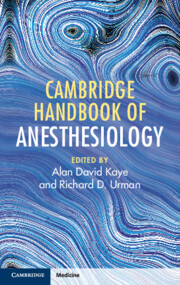Book contents
- Cambridge Handbook of Anesthesiology
- Cambridge Handbook of Anesthesiology
- Copyright page
- Dedication
- Contents
- Contributors
- Introduction
- Chapter 1 Preoperative Evaluation and Coexisting Disease
- Chapter 2 Airway Management
- Chapter 3 Anesthesia Equipment: Clinical Considerations
- Chapter 4 Patient Monitoring
- Chapter 5 Inhalational Anesthetics
- Chapter 6 Intravenous Anesthetics and Adjunctive Agents
- Chapter 7 Pharmacology of Local Anesthetics
- Chapter 8 Anesthesia Techniques: Mild, Moderate, and Deep Sedation in Clinical Practice
- Chapter 9 Anesthesia Techniques: General Anesthesia Techniques in Clinical Practice
- Chapter 10 Postanesthesia Care Unit
- Chapter 11a Regional Anesthesia: Blocks of the Upper and Lower Extremities
- Chapter 11b Regional Anesthesia: Chest and Abdominal Plane Blocks
- Chapter 12 Fluid and Electrolyte Balance
- Chapter 13 Blood Transfusion Components and Complications in Anesthesiology
- Chapter 14 Cardiac Anesthesiology
- Chapter 15 Vascular Anesthesia
- Chapter 16 Thoracic Anesthesia
- Chapter 17 Neuroanesthesia
- Chapter 18 Renal Anesthesiology in Clinical Practice
- Chapter 19 Anesthesia for General Surgical Procedures
- Chapter 20 Anesthesia for Endocrine Diseases
- Chapter 21 Anesthesia for Neuromuscular and Collagen Vascular Diseases
- Chapter 22 Anesthesia for Ocular, Ear, and Throat Diseases
- Chapter 23 Orthopedic Anesthesia
- Chapter 24 Obstetric and Gynecologic Anesthesia
- Chapter 25 Pediatric Anesthesia
- Chapter 26 Geriatric Anesthesia
- Chapter 27 Anesthesia for Ambulatory Surgical Procedures
- Chapter 28 Chronic Pain Medicine
- Chapter 29 Acute Pain Management
- Chapter 30 Anesthetic Emergencies
- Chapter 31 Trauma Anesthesia
- Chapter 32 Perioperative Cognitive Disorders
- Chapter 33 Acute Pain Management in the ICU
- Chapter 34 Infection Control for the Anesthesia Provider
- Chapter 35 Coagulation
- Index
- References
Chapter 34 - Infection Control for the Anesthesia Provider
Published online by Cambridge University Press: 24 May 2023
- Cambridge Handbook of Anesthesiology
- Cambridge Handbook of Anesthesiology
- Copyright page
- Dedication
- Contents
- Contributors
- Introduction
- Chapter 1 Preoperative Evaluation and Coexisting Disease
- Chapter 2 Airway Management
- Chapter 3 Anesthesia Equipment: Clinical Considerations
- Chapter 4 Patient Monitoring
- Chapter 5 Inhalational Anesthetics
- Chapter 6 Intravenous Anesthetics and Adjunctive Agents
- Chapter 7 Pharmacology of Local Anesthetics
- Chapter 8 Anesthesia Techniques: Mild, Moderate, and Deep Sedation in Clinical Practice
- Chapter 9 Anesthesia Techniques: General Anesthesia Techniques in Clinical Practice
- Chapter 10 Postanesthesia Care Unit
- Chapter 11a Regional Anesthesia: Blocks of the Upper and Lower Extremities
- Chapter 11b Regional Anesthesia: Chest and Abdominal Plane Blocks
- Chapter 12 Fluid and Electrolyte Balance
- Chapter 13 Blood Transfusion Components and Complications in Anesthesiology
- Chapter 14 Cardiac Anesthesiology
- Chapter 15 Vascular Anesthesia
- Chapter 16 Thoracic Anesthesia
- Chapter 17 Neuroanesthesia
- Chapter 18 Renal Anesthesiology in Clinical Practice
- Chapter 19 Anesthesia for General Surgical Procedures
- Chapter 20 Anesthesia for Endocrine Diseases
- Chapter 21 Anesthesia for Neuromuscular and Collagen Vascular Diseases
- Chapter 22 Anesthesia for Ocular, Ear, and Throat Diseases
- Chapter 23 Orthopedic Anesthesia
- Chapter 24 Obstetric and Gynecologic Anesthesia
- Chapter 25 Pediatric Anesthesia
- Chapter 26 Geriatric Anesthesia
- Chapter 27 Anesthesia for Ambulatory Surgical Procedures
- Chapter 28 Chronic Pain Medicine
- Chapter 29 Acute Pain Management
- Chapter 30 Anesthetic Emergencies
- Chapter 31 Trauma Anesthesia
- Chapter 32 Perioperative Cognitive Disorders
- Chapter 33 Acute Pain Management in the ICU
- Chapter 34 Infection Control for the Anesthesia Provider
- Chapter 35 Coagulation
- Index
- References
Summary
A newly acquired infection that a patient contracts during the course of receiving medical care is known as a healthcare-associated infection (HAI). These nosocomial infections are a serious source of morbidity and mortality for patients receiving care in hospitals, nursing homes, rehabilitation facilities, and surgery centers. HAIs include central line-associated bloodstream infections, catheter-associated urinary tract infections, ventilator-associated infections, and surgical site infections (SSIs). It is estimated that each day, 1 in every 31 patients in the United States is diagnosed with at least one of these nosocomial infections. Annually, approximately 2 million patients are diagnosed with a HAI in the United States, with 90,000 cases resulting in death [1, 2]. SSIs account for upward of 20% of all HAIs. Not only do they lead to an increase in the length of hospital stay, but they also are associated with increased readmission rates and the development of multidrug-resistant infections and drive up the cost of care. This contributes to an increase in healthcare costs of between 3.5 and 10 billion dollars per year [3, 4]. Just as staggering is the knowledge that it is estimated that up to 60% of SSIs are preventable. There are numerous factors that contribute to these infections. In recent years, there has been an increased awareness of the role that anesthesia providers can play in mitigating the risk of HAIs. Vigilant adherence to infection control measures is paramount to reducing perioperative HAIs [5].
- Type
- Chapter
- Information
- Cambridge Handbook of Anesthesiology , pp. 503 - 520Publisher: Cambridge University PressPrint publication year: 2023



